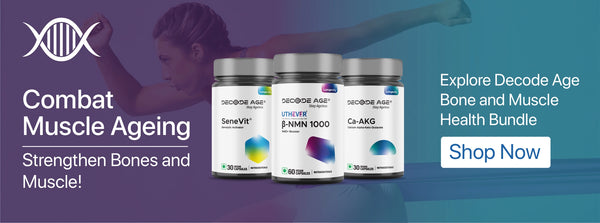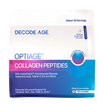Calcium Alpha-Ketoglutarate, nicotinamide mononucleotide, and senolytics are cutting-edge interventions in the fight against muscle ageing. As we age, the loss of muscle mass and strength becomes a significant concern, potentially leading to conditions like sarcopenia, and muscular dystrophy. This decline in muscle health can severely impact daily life, making tasks such as climbing stairs or walking quickly challenging. In this blog, we will discuss muscle ageing, the chronic diseases associated with ageing muscles and explore the potential of supplements to counteract these ageing effects on muscles.
How Does Muscle Degrade with Ageing?
As people age, their muscles gradually decline in size and strength, leading to fatigue, weakness, and decreased exercise capacity. This deterioration is due to a combination of factors: the reduction in muscle fibres, slower muscle tissue replacement by tougher fibrous tissue, and changes in the nervous system that reduce muscle tone and contraction capacity.
Muscle mass typically decreases by 3–8% per decade after age 30, accelerating after age 60. This loss of muscle mass, strength, and function may contribute to increased disability among older individuals, accompanied by a rise in fat mass, altered body composition, and a higher risk of insulin resistance.
With ageing, muscles undergo significant cellular changes, leading to a decrease in muscle cell quantity and a reduced capacity for rapid contraction and strength. The sarcoplasmic reticulum, crucial for calcium level regulation within muscle cells, also sees a reduction in volume. The structure of sarcomeres, fundamental units of muscle fibres, becomes disorganised, and muscle nuclei shift toward the centre of the fibre. Consequently, the muscle cell membrane's responsiveness declines and there is an increase in fat accumulation within and surrounding muscle cells.
Furthermore, the ageing process impacts the nervous system, resulting in a smaller number of signals reaching the muscles, a reduction in motor neurons, and less effective nerve regeneration. These changes lead to the formation of larger motor units. Satellite cells, vital for muscle growth and regeneration, are also adversely affected by ageing, which can impede muscle development over time and contribute to muscle ageing. Additionally, reduced levels of NAD+, a molecule essential for cellular energy production, further hasten muscle ageing by impairing muscle function and energy metabolism. These interconnected factors collectively contribute to the progressive decline in muscle health with age.
Chronic Diseases Associated with Muscle Ageing
As muscles age, several disorders or conditions can develop due to various factors that can significantly impact muscle health and function. Below are the diseases linked with muscle ageing.
Sarcopenia
Sarcopenia is an age-related condition characterised by the progressive loss of muscle mass, strength, and motor function, leading to impaired mobility and increased risk of falls, particularly in those over 65 years old. Symptoms include fatigue, weakness, difficulty maintaining balance and coordination, and decreased walking and standing ability. Causes of sarcopenia include ageing, insufficient exercise, malnutrition (especially inadequate protein and vitamin D intake), reduced testosterone levels, and chronic inflammation. These factors contribute to an imbalance between muscle production and breakdown, worsening the condition.
Autoimmune conditions
The immune system comprises a complex network of tissues, organs, and cells to defend the body against harmful organisms like bacteria and viruses, thus preventing infection and disease. However, in individuals with autoimmune conditions, the immune system targets and attacks its healthy cells and tissues. This can lead to inflammation, tissue damage, and various symptoms depending on which tissues or organs are affected.
- Myositis
Myositis, an autoimmune condition, causes chronic inflammation and muscle weakness, affecting skeletal muscles throughout the body, including those around the eyes, oesophagus, and diaphragm. While its cause remains uncertain, treatments focus on symptom management through exercises and medical care.
- Myasthenia Gravia
Myasthenia gravis is a chronic neuromuscular disease causing weakness in voluntary muscles due to autoimmune attacks. Symptoms include weakness of eye muscles, drooping eyelids, blurred vision, difficulty swallowing, shortness of breath, and weakness in limbs and neck.
Genetic conditions
Genetic disorders result from mutations in genes, altering DNA instructions for cell function and unique traits. Mutations can be inherited from one or both parents or occur spontaneously, increasing the risk of genetic disorders. Symptoms may be present at birth or develop gradually over time.
- Muscle Atrophy
Muscle atrophy is the loss or thinning of muscle tissue, resulting in decreased mass and strength. It can arise from malnutrition, ageing, genetics, inactivity, or certain medical conditions. Less use of muscles and neurogenic atrophy occur respectively from insufficient muscle use and nerve-related issues.
- Muscular Dystrophy
Muscular dystrophy (MD) covers genetic conditions causing progressive muscle weakening due to abnormal genes. Symptoms, varying in onset and severity, affect movement, potentially leading to immobility. Complications like difficulty swallowing may arise, but MD isn't contagious or triggered by injury/activity.
Supplements That Can Help with Muscle Ageing
Supplements that can slow down muscle ageing include Ca-AKG, NMN, Senolytics, Omega 3 fatty acids, Vitamin D, Vitamin C, and Creatine. They enhance muscle growth, vitality, endurance, and overall muscle health.
Ca-AKG
Ca-AKG derived from Alpha-ketoglutarate (AKG) a precursor to amino acids and a facilitator of the Krebs cycle, promotes efficient energy production and protein turnover in muscle cells. Additionally, AKG acts as a signalling molecule, modulating pathways involved in muscle growth and repair. By supporting these fundamental physiological processes, AKG helps mitigate muscle ageing by preserving muscle mass, strength, and function over time. Its involvement in nutrient metabolism and cellular signalling underscores its potential as a nutritional intervention to combat age-related muscle decline (He et al., 2015b).
NMN
NMN, a key NAD+ booster, is essential for replenishing energy levels and counteracting muscle ageing. It significantly enhances muscle function and strength by improving cellular energy production and metabolism. This action is vital in combatting the natural decline in muscle functionality with age. Furthermore, NMN supports cellular repair and maintenance processes, which are critical in maintaining muscle integrity over time. By providing cells with the resources needed for optimal performance and recovery, NMN not only promotes muscle health but also actively contributes to reducing age-related muscle deterioration (Yi et al., 2022)
Senolytics
Senolytics are drugs aimed at selectively eliminating senescent cells—cells that have ceased to divide and contribute to muscle-related diseases. These cells release substances known as the Secretory secretory-associated senescent Phenotype (SASP), which can damage adjacent healthy cells and deteriorate tissue health. Fisetin, a senotherapeutic compound, targets and removes these senescent cells, aiding in the preservation of muscle function. Its anti-inflammatory and antioxidant properties further bolster muscle health. Quercetin, found abundantly in fruits and vegetables, helps maintain muscle function by fighting oxidative stress and inflammation. Combining fisetin and quercetin supplementation emerges as a potent approach to counteract age-related muscle decline and enhance overall health span.
Omega 3 fatty acids
Omega-3 polyunsaturated fatty acids, also known as fish oils, possess valuable anti-inflammatory properties. These fatty acids are essential for constructing cell membranes and aiding in skeletal muscle development. Certain components of fish oil, such as eicosapentaenoic acid (EPA) and docosahexaenoic acid (DHA), have been observed to sensitize muscles to growth signals, potentially leading to increased muscle mass.
Vitamin D
Vitamin D plays multiple roles in promoting muscle growth, including facilitating stem cell generation, protein synthesis, and energy production. Inadequate dietary intake of vitamin D has been linked to musculoskeletal disorders, with older adults being particularly vulnerable due to reduced absorption through digestion or sun exposure. Increasing vitamin D intake through diet or supplementation has shown promise in reducing the risk of osteoporosis and sarcopenia in the elderly. Food sources rich in vitamin D include oily fish, red meat, liver, egg yolks, mushrooms, and fortified foods.
Vitamin C
A significant portion of the body's vitamin C is found in skeletal muscles, where it contributes to bone health and muscle mass maintenance. Vitamin C aids in carnitine production, which provides energy for muscle function, and collagen synthesis, a structural protein in muscle fibers. Additionally, vitamin C exhibits anti-inflammatory effects against age-related diseases and has been associated with increased muscle mass gain. Fruits and vegetables such as citrus fruits, peppers, strawberries, broccoli, Brussels sprouts, and potatoes are readily available dietary sources of vitamin C.
Creatine
Creatine, a small protein synthesized in the liver, may benefit muscle growth when consumed through diet or supplements. Studies have shown that supplementing with creatine alongside resistance training enhances its benefits compared to resistance training alone. However, creatine supplementation alone may not address sarcopenia without accompanying exercise.
Conclusion
In conclusion, age-related muscle decline is a significant concern, but interventions like Ca-AKG, NMN, and senolytics offer promising solutions. These supplements support energy production, cellular repair, and the removal of senescent cells, preserving muscle function. Additionally, omega-3 fatty acids, vitamin D, vitamin C, and creatine play essential roles in promoting muscle health. Incorporating these interventions into our lifestyle can help mitigate age-related muscle decline and maintain optimal muscle function as we age.


















Leave a comment
All comments are moderated before being published.
This site is protected by hCaptcha and the hCaptcha Privacy Policy and Terms of Service apply.